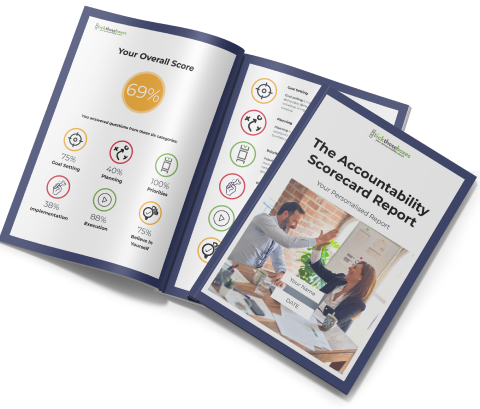Change in business isn’t always loud. Sometimes, it creeps in slowly. Margins may shrink, customer interest might fade, and the team could feel somewhat stuck. If you’re running a business, such changes can be tough to face. However, recognising when a strategy is no longer effective is more crucial than clinging to an outdated approach that has reached its limits. Pivoting a business model isn’t about failure. It’s about seeing where your plan no longer fits the direction things are heading and choosing to act on it.
Discover your Accountability Score and increase the probability of smashing your GOALS and Getting Sh!t Done!
Being too engrossed in the daily grind can hinder the ability to recognise these early signs. That’s where stepping back makes a difference. An entrepreneurship coach can give that outside perspective and keep you grounded while you rethink things. They don’t replace your insight but help focus it. Pivoting works best when it’s done with purpose, not panic. And that begins with knowing what signs to look for.
Recognising the Warning Signs
Your business may be attempting to communicate with you if it consistently operates in second gear. Before things spiral, there are usually a few markers that make it clear a change is needed. These warning signs often show up across several parts of the business, not just one.
Be vigilant for the following indicators:
– Drop in revenue and profit even when people are still spending in your industry
– More negative feedback or a growing number of customers who don’t return
– Regular operational issues that slow down delivery or cost more than they should
– A growing feeling that your service or product no longer stands out
One founder we worked with had a business centred around events. After years of success, bookings began to dry up, and clients started seeking more digital options. Waiting it out didn’t help. But once they accepted the shift and redesigned their offering to include online experiences, business picked up again. Recognising the shift early helped them adapt instead of staying stuck.
Sometimes, the signs aren’t financial. You may feel like your team’s creativity has peaked, or the work no longer excites you. That personal energy shift is just as important to notice. If you lose interest or direction, it’s not about pushing through harder. It’s time to ask if the business has outgrown its current path.
Building a Resilient Pivot Strategy
Deciding to pivot isn’t a quick fix. A powerful shift comes from steady planning, not rushing headfirst into something new. Once you’ve seen the signs, the next step is building a framework to move in a better direction with intention.
Here’s where to start:
1. Review what’s still strong
Work out what parts of your business still add value. Don’t scrap everything just because one part isn’t working. Keep the strengths and build on them.
2. Research what’s changing
Trends can shift quickly. Look into how client needs are evolving or what gaps are opening in your market. This helps you predict rather than react.
3. Set clear goals for the pivot
Ditch the vague targets like “we want to grow” and choose concrete markers. What does success look like in the short and medium term?
4. Create an action plan
A good pivot needs steps, not just ideas. Outline priorities, delegate tasks, and set deadlines for each milestone. Then follow through.
This stage is also where guidance helps most. When the stakes feel high, it’s easy to avoid decisions altogether or flip-flop between outcomes. Having someone to challenge your thinking and offer another view makes your plan stronger and your direction clearer. That clarity is key to getting your business back on a growth track where the effort starts to feel worth it again.
Implementing the Pivot
Shifting your business model is one thing. Making that shift stick is another. Once the plan is in place, bringing it to life needs careful execution. Everyone on your team has to understand the change, why it’s happening, and what their role within the pivot looks like.
Start by being upfront with staff and stakeholders. Catching people off guard can lead to confusion and eventual resistance. Share your reasons clearly. Talk about what’s changing, what’s staying, and how the business will benefit down the line. This approach builds trust before taking action.
A strong pivot usually means people need to grow into new roles or processes. Should your team be unfamiliar with the upcoming changes, please consider investing in the appropriate training. Whether it’s new systems, fresh responsibilities, or adjusted targets, support people long enough for them to feel confident. Good training also cuts down on mistakes during the transition.
Your systems might need changes too. If the pivot involves altering the delivery of services or production of products, the underlying processes must align accordingly. That could be updating workflows, changing suppliers, or using different tech. It may feel like a big lift upfront, but skipping this step can break consistency down the line.
Monitor the impact of the changes as they are implemented. Set short progress checks and simple markers. Is the new model moving you closer to your goals? Are customers responding differently? Are teams handling the transition effectively while maintaining a healthy work-life balance? If something isn’t landing, don’t wait months to tweak it. Adapting early can stop bigger problems later.
The Value of Working with an Entrepreneurship Coach
Going through a pivot can feel isolating. Even when the situation is changing, everyone expects leadership to provide the answers. That’s why an entrepreneurship coach can be helpful. They bring clear thinking and accountability when it matters most.
A coach doesn’t get caught up in the day-to-day issues. They ask pointed questions, challenge assumptions, and help set a pace that’s right for your stage of change. You don’t just get advice. You receive a structured system to help you stay committed to your goals, especially when distractions tempt you to stray from the plan.
Think of a founder sitting on pages of idea maps. Each one is good, some even great, but none are focused. An entrepreneurship coach helped her narrow it down, link actions to clear payoffs, and stop overthinking the rest. In a few months, what started as noise became a fully executed pivot into a high-demand niche.
During the messier stretches, when things move slower than hoped, when feedback is mixed, or when doubt creeps in, a coach helps you stay aligned with the reason you started the pivot in the first place. Maintaining the balance between strategy and consistency on your own can be challenging. The right support keeps the whole process moving forward.
Thriving Post-Pivot: The Path to Sustained Success
Once your new direction is in motion, the focus shifts. You’re not just trying something different. You’re settling into it. This period is where discipline counts. A pivot doesn’t mean instant results. It’s about staying sharp after launch to cement stability in the long run.
Make time to check in regularly with your team and track the work. Are the new systems holding up? Does customer feedback indicate improvement? Are sales or satisfaction numbers rising? Ask these questions often and act on the answers. Monitoring is less about perfection and more about progress.
Please continue enhancing what is effective rather than waiting for issues to arise. When one part of your pivot clicks, see where that success can be copied across other areas. Encourage teams to contribute innovative ideas, even when they appear to have completed the major tasks. Staying proactive avoids getting comfortable again.
Wins, whether small or big, deserve attention. Celebrating reachable milestones helps everyone see momentum. It also boosts morale and helps reinforce team buy-in. That energy matters, especially during the slower periods where change continues without fanfare.
Still, pivoting isn’t a one-time project. What worked today may need tweaks a year from now. Over time, the most effective leaders remain receptive to coaching and feedback. This mindset of long-term accountability builds the kind of business that doesn’t just recover. It grows stronger.
Tick Those Boxes specialises in helping individuals and organisations become more accountable. Contact our team to see how our programs may help you establish a more effective and accountable workplace, allowing you to do the things you say you will do and getting your teams to do the same.
Working with an entrepreneurship coach can bring clarity, structure, and renewed direction when your business is facing change. At Tick Those Boxes, we help individuals and organisations become more accountable. Contact our team to see how our programs may help you establish a more effective and accountable workplace, allowing you to do the things you say you will do and getting your teams to do the same.


